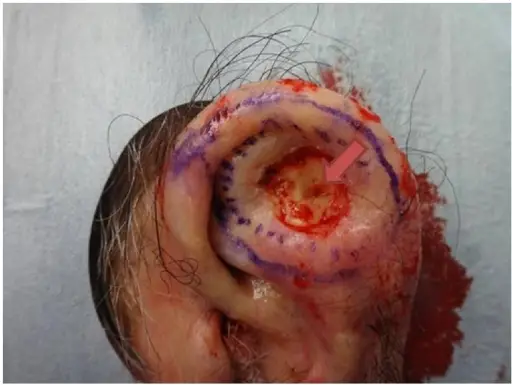Squamous cell carcinoma of the ear is a form of skin cancer that develops within the middle and outer layer of skin in the ear canal. This condition is life-threatening as the tumor can spread to the brain and the nerves around the ear.
What is the Pathology of Squamous Cell Carcinoma of the Ear?
The pathology of squamous cell carcinoma of the ear is:
-Etiology: The cause of squamous cell carcinoma of the ear is from prolonged exposure to ultraviolet (UV) radiation.
-Genes: XP xeroderma pigmentosum (XP).
-Pathogenesis: The sequence of events that lead to squamous cell carcinoma of the ear is propagation of genetic aberrations and malignant growth.
-Histology: The histology associated with squamous cell carcinoma of the ear shows infiltrative malignant cells with keratinization, and intercellular bridges.
How does Squamous Cell Carcinoma of the Ear Present?
Patients with squamous cell carcinoma of the ear typically are male present at the age range of 50s and 60s that spend an increased amount of time exposed to the sun. The symptoms, features, and clinical findings associated with squamous cell carcinoma of the ear include long standing chronic otitis media with sudden onset of pain, otorrhea, and hemorrhage. Most squamous cell carcinomas will grow and spread if untreated.
How is Squamous Cell Carcinoma of the Ear Diagnosed?
Squamous cell carcinoma of the ear is diagnosed by a physical examination and biopsy.
How is Squamous Cell Carcinoma of the Ear Treated?
Squamous cell carcinoma of the ear is treated by a radical surgery with or without radiation therapy or chemotherapy.
What is the Prognosis of Squamous Cell Carcinoma of the Ear?
The prognosis of squamous cell carcinoma of the ear is poor if untreated.



